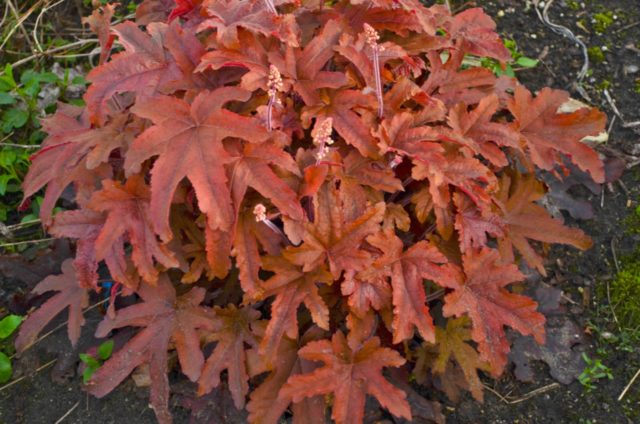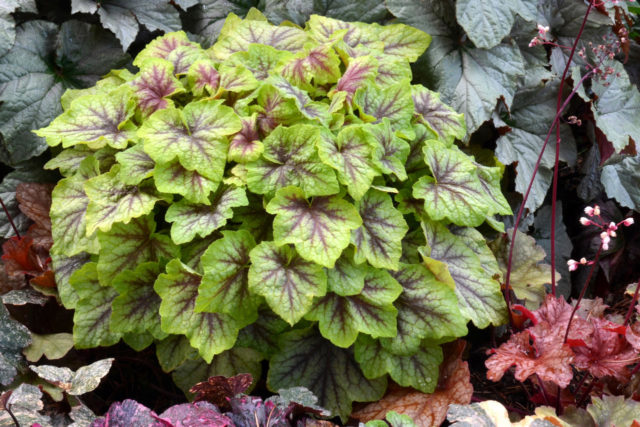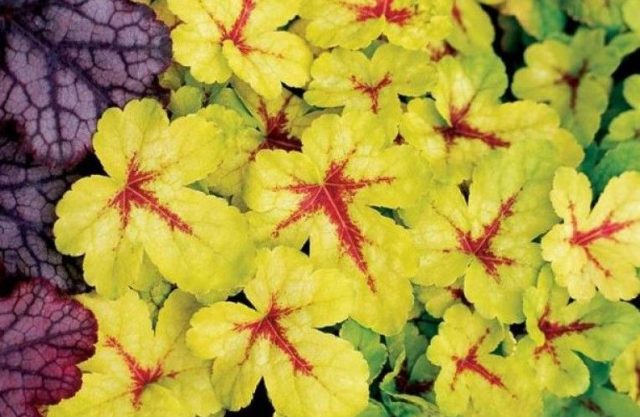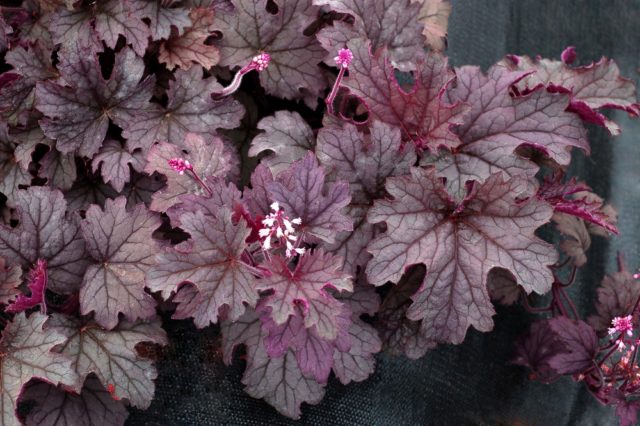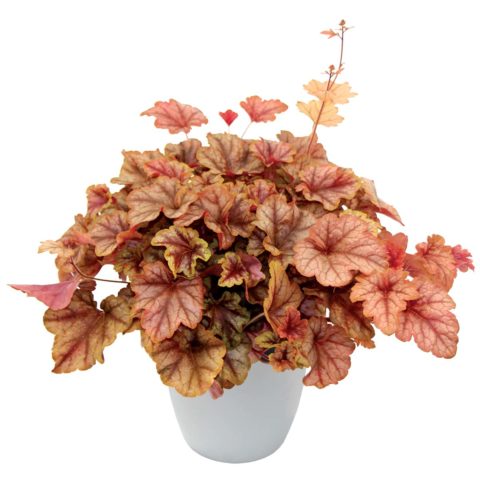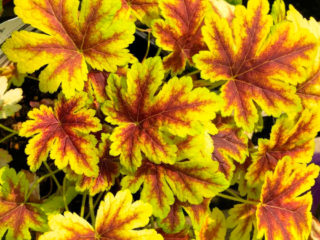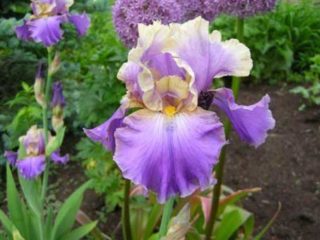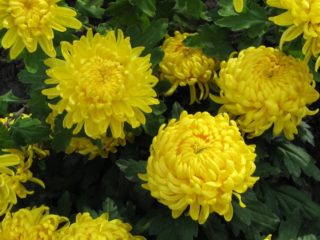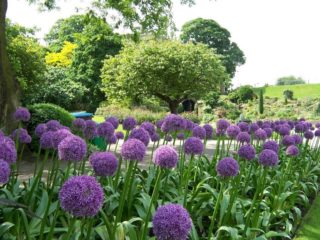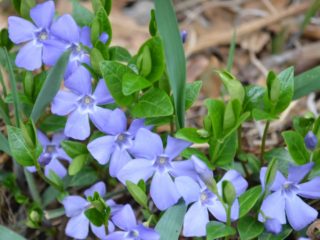Content
Geyherella is one of the many herbaceous plants widely used in landscape design. For more than 100 years of the existence of this hybrid, breeders have bred a fairly large number of its varieties. The varieties and types of Heykherella with a photo and a name, a description of which is given below, are the most famous, they can be found more often than others.
Description of heykherella with photo
In the wild, Heucherella does not grow, since this plant is an artificially bred hybrid. It was obtained as a result of intergeneric crossing of Heuchera (Latin Heuchera) and Tiarella (Latin Tiarella) in 1912 in France. As a result of further breeding work, many varieties of Heycherella were bred, and now this plant is rightfully considered one of the most popular among fans of decorative gardening.
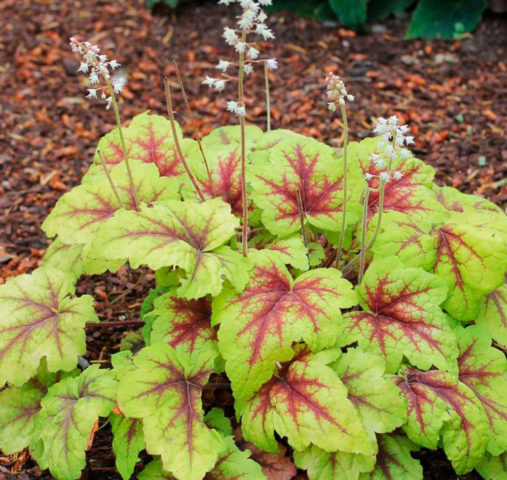
The pattern on the leaves of heykherella gives the plant a special flavor
The main parameters and characteristics of this plant are summarized in the table:
Parameter | Value |
A type | Herbaceous perennial plant. |
General form | Hemispherical compact bush of medium density up to 0.7 m high and up to 0.5 m wide. |
Escapes | Erect, very flexible, reddish. |
Leaves | Strongly dissected, lobed, resembling maple in shape, of various colors with an internal pattern. The leaf plate is pubescent below, the petiole is long, fleecy. |
Root system | Superficial, with strongly branched thick roots. |
Flowers | Small, light, of various shades, collected in paniculate inflorescences on bare peduncles. |
Fruit | Not formed, the plant is sterile. |
Varieties and types of heykherella
There are a huge number of varieties of Heycherella in the world. Breeding work in this direction continues, so new items appear almost every year. Here are the main varieties and types of Heycherella (with photo), the most common in landscape design and ornamental gardening.
Solar Eclipse
Geyherella Solar Eclipse with its color really resembles a solar eclipse. The leaves are rounded, very showy, reddish-brown, bordered with a light green stripe. The bush is compact, 0.25-0.3 m high. Flowers are small, white, collected in small loose panicles.

Geyherella Solar Eclipse blooms in early summer
Redstone falls
Geyherella Redstone Falls is a relatively young variety, it was bred only in 2016. The plant is a spreading wide bush about 0.2 m high. The color of the leaves depends on the intensity of the light. With a large amount of sunlight, the color of the plates is red with darker veins; with weaker illumination, the foliage becomes orange or yellow with a green tint. The flowers are small, light pink, collected in medium-sized panicles.
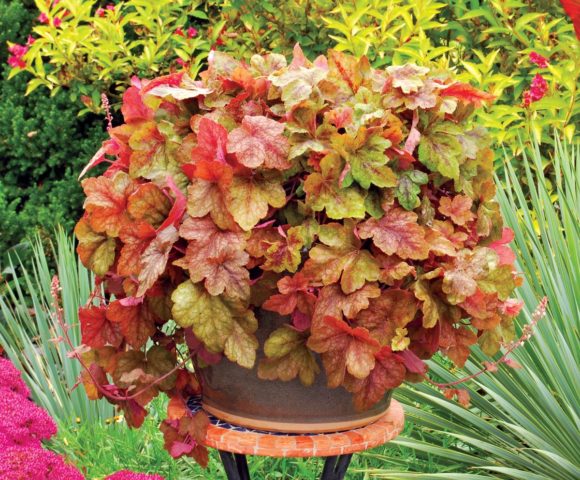
Geyherella Redstone Falls can grow as a potted species
Hopscotch
Geyherella Hopscotch (Hopscotch) grows in the form of a rounded bush with a height and width of 0.4-0.45 m. The color of the leaves resembles the flesh of a grapefruit, something between red and orange, around the veins the color is more dense.In the heat, the leaf plates turn yellowish-green with an olive tint, and in the fall - red with a bronze tint. In May-June, the plant appears numerous small flowers with white petals.
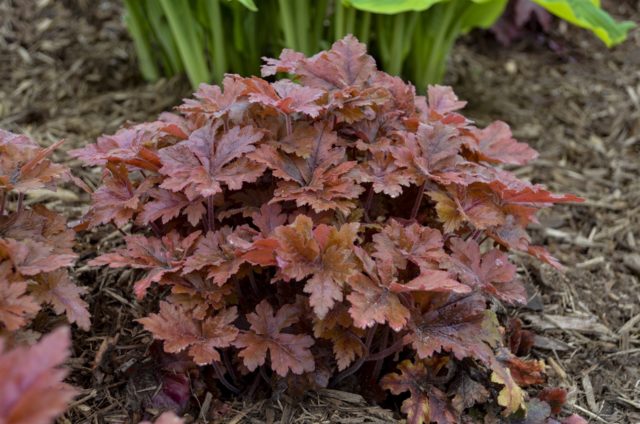
Hopscotch color changes throughout the season
Sweet Tee
Geicherella Sweet Tea (Sweet Tea) grows as a wide spreading bush about 0.4 m high and 0.6-0.65 m wide.The leaves have a red-orange color with a tinge of cinnamon, and in summer the color is darker and more saturated, in the fall the plates become light. Flowers are white, small, appear in early summer.
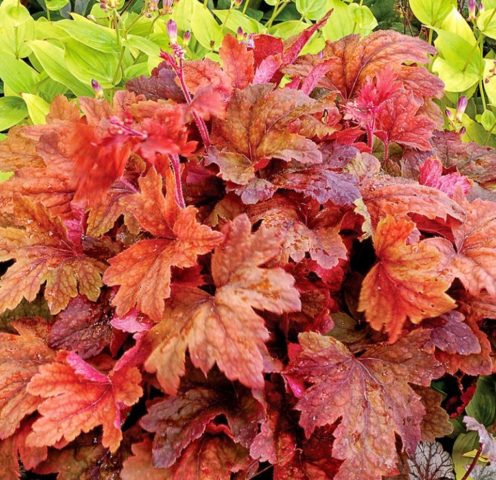
Sweet Tee is a relatively young variety, bred in 2008 in Oregon (USA)
Kimono
Geyherella Kimono is a short, rounded bush with a height and a diameter of about 0.3 m. The variety is distinguished by a star-shaped leaf shape with an elongated central ray. The plate is green with a silvery tint, brownish near the veins. Flowers pinkish-white, appear in May-June.
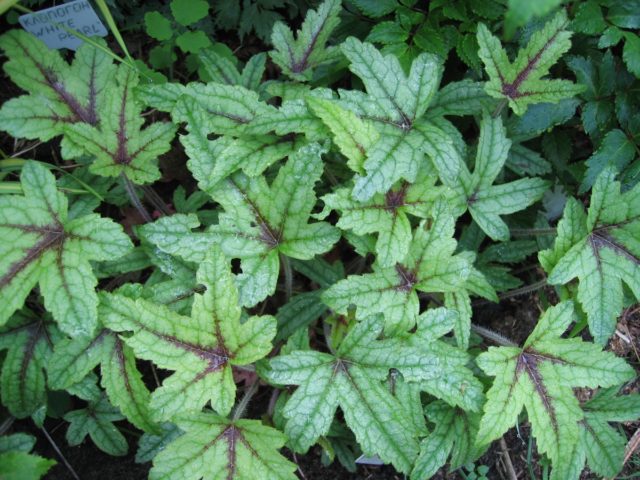
Heykherella Kimono leaves have a strongly serrated edge
Sunrise Falls
Geyherella Sunrise Falls forms a low creeping bush about 0.2-0.25 m high and up to 0.7 m in diameter. The leaves are bright yellow, with ocher patterns along the veins. By autumn, the color becomes more saturated, the red color becomes predominant. Flowers are white, small, collected in wide loose panicles.
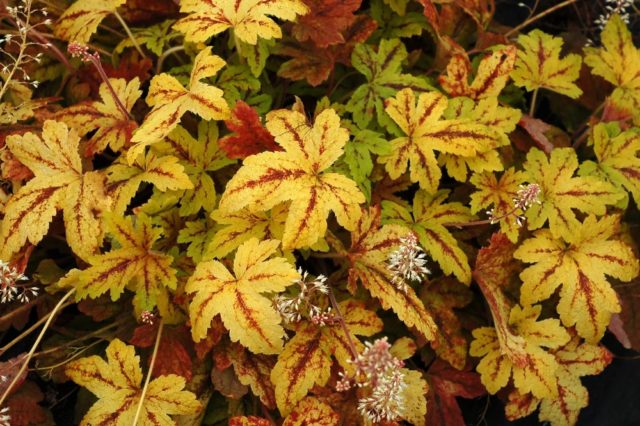
Sunrise Falls blooms in mid-summer
Stoplight
Heycherella Stoplight forms a rather undersized bush, its height is only about 0.15 m, while the diameter can be 0.25-0.3 m. The leaf plate has rounded contours, painted yellow with a greenish tint. The central part and veins are bright, burgundy. As it grows, the amount and intensity of the red color increases. Flowers are small, white, collected in loose inflorescences - panicles, appear in early summer.
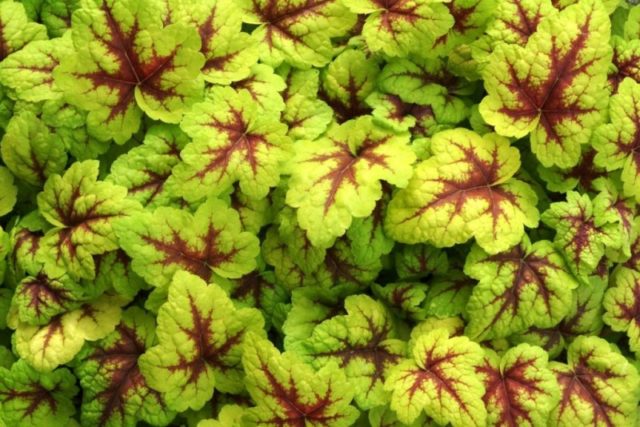
Geyherella Stoplight is often used as a curb plant
Solar Power
Geyherella Solar Power (Solar power) forms a hemispherical bush of average density about 0.3 m high and 0.4 m in diameter. The leaf plates have rounded contours. They are light yellow with reddish-brown spots along the veins and in the region of the central part; as they grow, the color becomes darker, a green tint appears.

Geyherella Solar Power blooms in mid-May
Buttered rum
Geyherella Buttered Rum has a very bright expressive color of leaves. During the season, the color of this variety changes from caramel-orange at first to red-pink, and by autumn it becomes rich burgundy. Flowers are medium-sized, white, beginning to appear in the second half of May.

Geyherella Buttered Ram - Fall Colors
Honey rose
Geicherella Honey Rose forms a wide hemispherical bush about 0.3 m high. The color of the leaves of this variety is unusual, dark veins on a coral-pink background form a complex pattern. Peduncles appear on the plant in late spring.
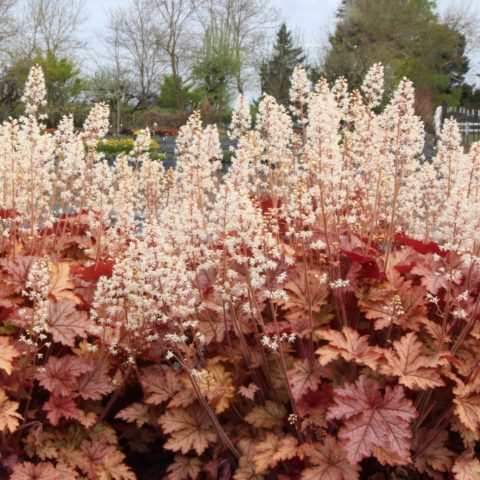
Numerous Honey Rose flowers with cream-colored petals are collected in lush cone-shaped panicles
Alabama Sunrise
Geyherella Alabama sunrise is distinguished by rather large rounded leaves. During the season, their color changes from light green-yellow to yellow-orange, while the veins and the central part of the plate have a reddish-brown tint. Bushes with a height and diameter of no more than 0.3 m. Flowers are white, appear in June.

Alabama Sunrise bushes are low and rounded
Tapestri
Tapestry has leafy plates of an unusual shape, 2 blades are pronounced on them. Their color is also very specific. The edge of the leaf is green with a bluish tint, then the shade changes to silver. The veins and the center are colored violet-blue. Light pink flowers appear in mid-summer. The Tapestry heycherella bush is compact, about 0.25 m high, with peduncles up to 0.4 m.
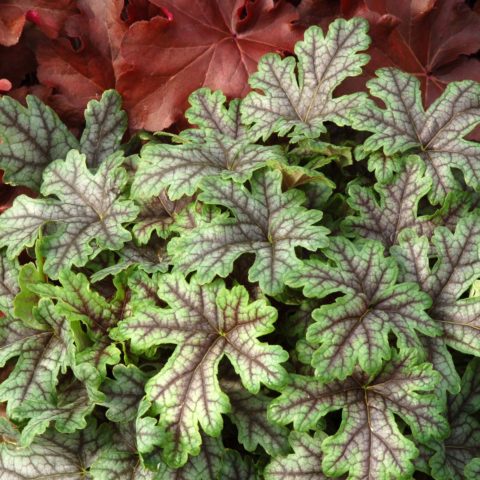
Geyherella Tapestri will appeal to fans of non-standard colors
Brass Lantern
Geyherella Brass Lantern (Brass Lantern) grows as a low spreading bush about 0.3 m high and 0.5 m in diameter.The foliage of this variety is very bright, has a golden peach color with red veins and a center. In June, the plant develops numerous small flowers, due to which the plant's height increases by almost 1.5 times.
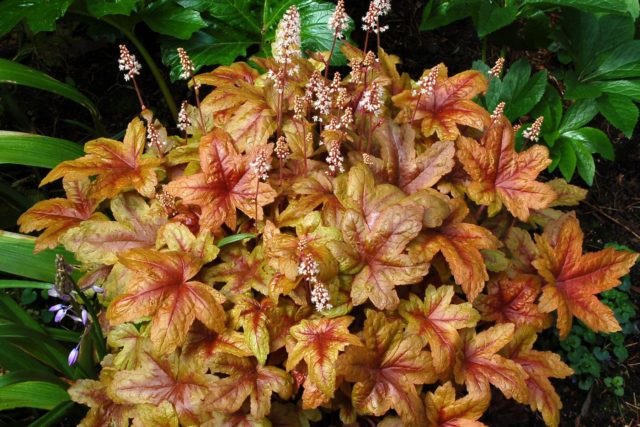
Inflorescences Brass Lanteri - small cone-shaped panicles
Hansmoak
Geyherella Gunsmoke changes color of the leaves several times during the season. In early spring they are brown, in May the plates turn purple-red. Over time, the leaves acquire an ash-silvery hue, it lasts until autumn. After that, the color returns to brown tones with an orange tint. Against the background of a dark bush, numerous white flowers that appear in May look very decorative.

Height of Heycherella Hansmoke with peduncles - about 0.35 m
Bridget Bloom
Bridget Bloom Geyherella begins to bloom in June. At this time, numerous light coral petals stand out brightly against the background of juicy green leaves with brown veins and a dark center. Bush up to 0.3 m high, with peduncles up to 0.45 m.
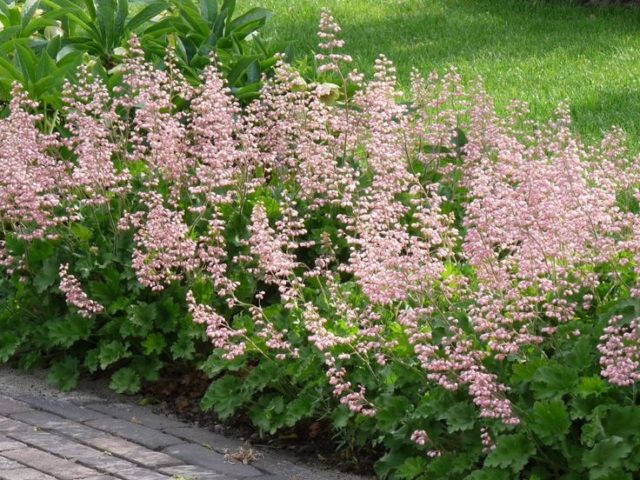
Bridget Bloom bush short, compact
Mint frost
Mint Frost (Mint Frost) - one of the late flowering varieties of Heycherella. Numerous buds with cream-colored petals begin to appear on this plant only in the last summer month. The leaves are green, with a dense silver tint, which intensifies towards the end of the season. At the same time, red tones begin to appear in the color by autumn. The bush is low, up to 0.25 m, the diameter does not exceed 0.35 m.
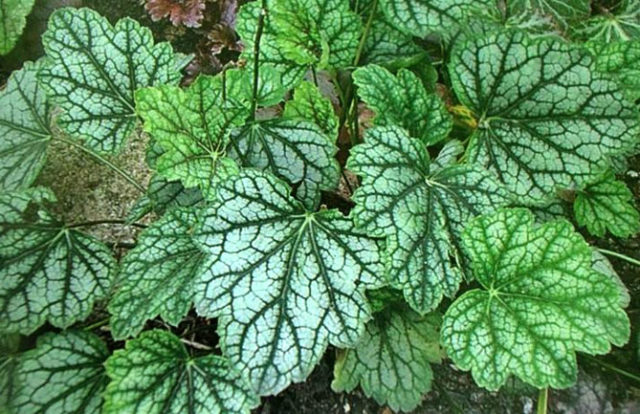
The silvery color of the leaves of Mint Frost resembles hoarfrost.
Burnished bronze
Geyherella Barnished Bronze (Burnished Bronze) grows as a spreading bush up to 0.25 m high, while its width can reach 0.45 m. The leaves of the plant are colored in various shades of bronze. Numerous paniculate inflorescences with pale pink petals adorn this variety from May to July.
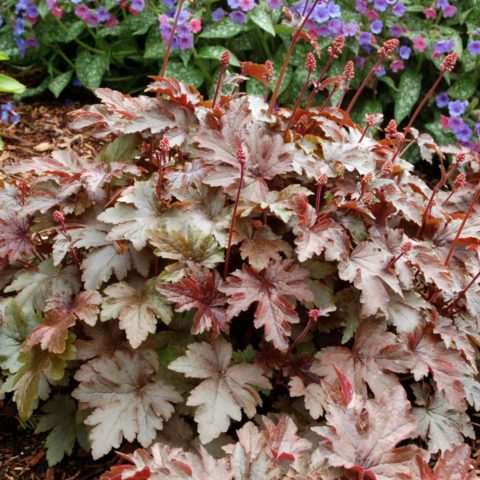
Geyherella Barnished Bronze blooms profusely and continuously
Yellowstone falls
Geyherella Yellowstone Falls is a small compact shrub about 0.2 m high and twice as wide. The leaf plates are rounded, colored yellow-green. In the central part and along the veins, numerous rounded crimson specks are visible. This variety blooms in early summer.
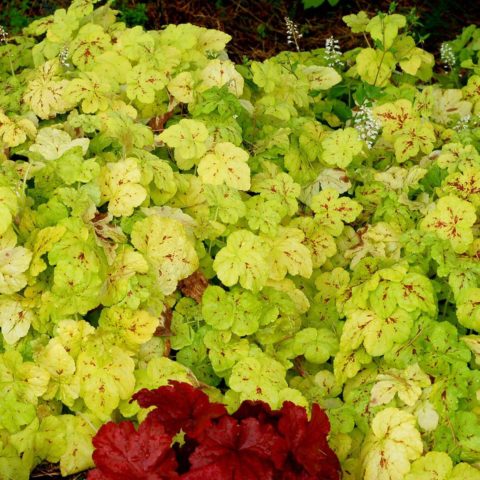
Geyherella Yellowstone Falls can be used as a ground cover
Geyherella in landscape design
Due to the abundance of shapes and colors, heycherella has found wide application among both amateurs of decorative gardening and among professional landscape designers. The plant is used to create mixborders and flower beds in which different varieties are combined.

Geyherella goes well with large stones
Geyherella is planted along rocky paths, near the walls of houses and buildings. The bushes look great both in single plantings and in groups.
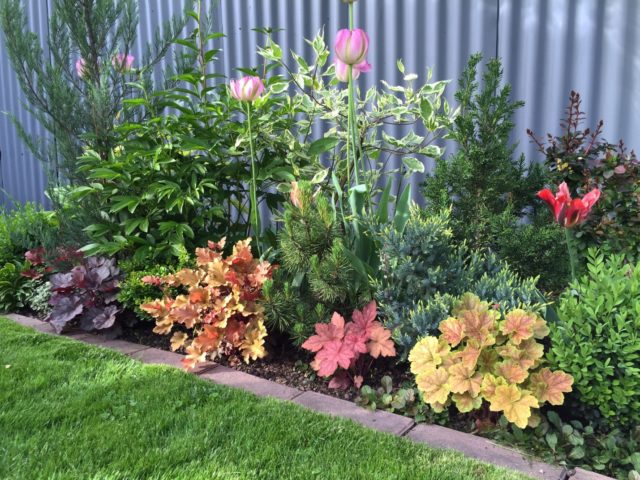
Geyherella looks great in mixed plantings
Due to its small size, Heycherella can be used as a container plant in the garden. It will look great in a flowerpot or on a dais.

Heycherella can be grown in a potted version
Here are some Heycherell varieties that are suitable for use in landscaping:
- Ed Rover (Red Rover). A very decorative variety with thin, carved red leaves with a tinge of copper. The veins and the middle are burgundy. In the heat, it takes on an olive tint. The height of the bush can be up to 0.25 m, the width is twice that.
Red Rover variety begins to bloom in June
- Fire Frost (Fire Frost). A variety with wide leaves of a yellow-green hue, with burgundy-brown veins. Bush up to 0.35 m in height. Flowers are small, white, appear in early summer.
Fire Frost bush round and compact
- Sunspot (Sunspot). The plant forms a rounded bush with a height of about 0.25 m and a rosette diameter of up to 0.4 m. The leaves are round, yellow with a golden tint, the veins and the central part are claret-brown. Numerous flowers with pink petals adorn the plant throughout the first half of summer.
The pattern in the central part of the leaves of Heycherella Sunspot visually resembles a star with an elongated central ray
- Plum Cascade (Plum Cascade). The plant forms a rounded, spreading bush about 0.25 cm high and 0.5-0.6 m in diameter. The leaf plates are carved, with a clearly delineated folded edge, of a violet tone with a silver tint. The flowers are light pink and grow almost throughout the summer.
Plum Cascade has a long flowering period
- Cooper Cascade (Cooper Cascade). A very beautiful, bright red bush, the foliage of which has peach, coral and copper shades. Height about 0.3 m, diameter slightly larger. Flowers with white petals appear at the beginning of the first summer month.
Cooper Cascade looks great as a potted plant
Reproduction methods
Heycherella cannot be propagated by seed, as it is an artificial hybrid that does not produce fruits. Therefore, this plant can only be propagated vegetatively, using methods such as dividing the rhizome or grafting.
To cut cuttings from a bush, you need to take young annual shoots that appeared in the spring. They are rooted in water with the addition of a root formation stimulant, for example, Kornevin. It may take about 1 month for cuttings to form their own root system. They can then be transplanted into a container with a nutrient medium or into a nursery greenhouse. Usually rooted cuttings take root well and start growing quickly. After the appearance of several pairs of leaves, you can transplant the seedlings to a permanent place in the open ground.
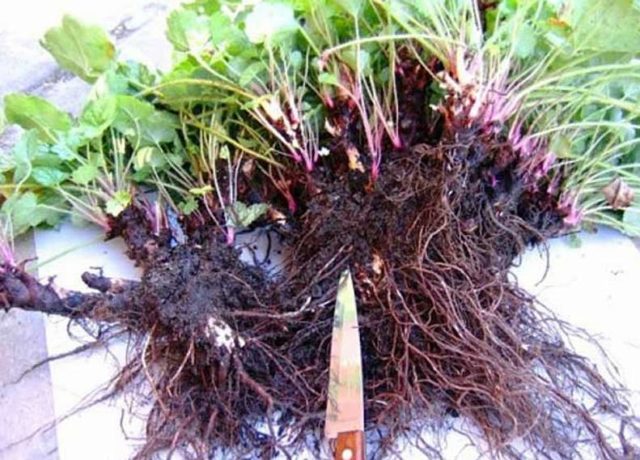
2-3 growth buds should remain on each division.
Dividing a bush is the best way to propagate heycherella. It is recommended to divide an adult bush once every 3-4 years, this will not only increase the decorative effect of the plant, but also prevent its aging. This can be done in late July or early August. The main stages of this procedure are:
- The bush is completely dug out of the ground.
- The roots are washed with water from a hose or in a bucket.
- Cut off dried stems.
- With an ax or a knife, the rhizome is divided into parts so that in each division there are several shoots with their own root system.
- The resulting seedlings are planted in a permanent place.
Planting and leaving
Geyherella is a rather unpretentious plant and usually does not cause much trouble for the gardener. If you choose the right place for planting it and provide the shrub with at least minimal care, then it will annually delight you with its decorative appearance.
When and how to plant
Most often, heykherella is planted immediately after dividing the rhizome. This procedure is carried out after flowering, in late summer or early autumn. By the same time, seedlings are gaining strength, which are grown from annual cuttings. The landing site is chosen taking into account the following requirements:
- Diffuse sunlight or partial shade from larger trees or objects.
- Loose, breathable fertile soil.
- Neutral or slightly alkaline soil reaction.
- Good drainage of flower beds or beds.
- The occurrence of groundwater is far from the surface.
- The site should not be swampy or flooded.
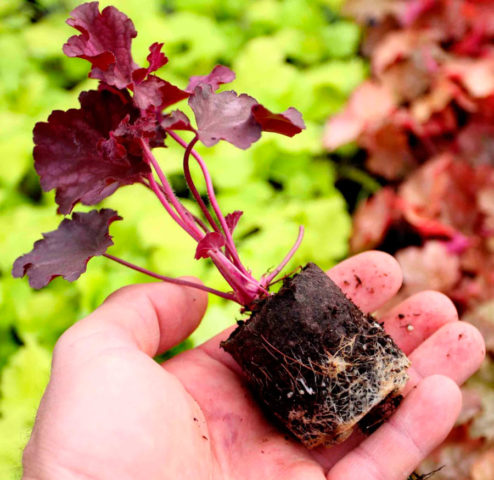
The transplant is carried out together with a lump of earth on the roots.
A flower bed or a site for planting heykherella must first be dug up, adding a small amount of phosphorus and potassium fertilizers. Organic matter, for example, humus with wood ash, is also suitable. Seedlings or cuttings are installed vertically in the holes at a distance of 0.3-0.35 m from each other, if the planting is group. The root system is covered with soil, and then the flower bed is abundantly moistened.
Growing features
Although heycherella belongs to frost-resistant plants, it is better to cover it with spunbond or other material for the winter. This is not due to the cold, but to the need to protect the plant from sunlight. Geyherella hibernates without shedding leaves.When the bright sun hits them, strong evaporation of moisture occurs, while the dormant root system is unable to compensate for its loss. If you do not protect the plant during this period, then by the spring it will simply dry out. The rest of the care procedures do not differ from the standard ones.
Diseases and pests
Heycherella is resistant to diseases and pests. Only the wrong choice of a planting site, a violation of the water regime, or an increased acidity of the soil can weaken its condition. Excess moisture can provoke the appearance of root rot, in which case the plant must be dug up and transplanted to a more suitable place. For the same reason, other fungal diseases such as powdery mildew or brown spot can develop. The affected areas must be cut and burned, and the shrub itself must be treated with fungicides.
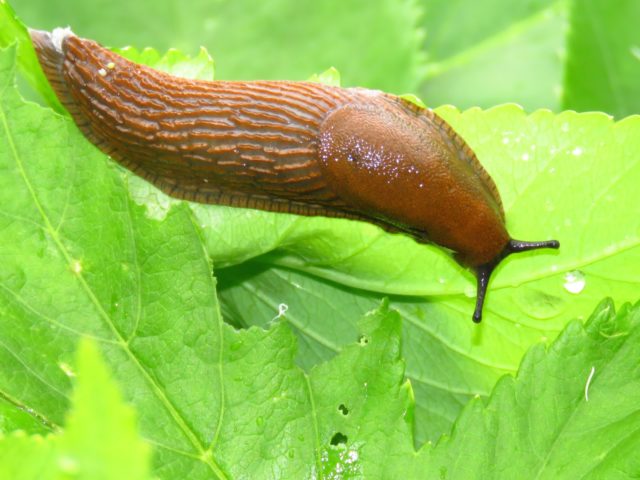
Slugs damage not only heycherellas, but also many other garden plants.
If the Heycherella planting site is shaded and humid, then slugs can attack it. These gastropods can greatly spoil the decorative effect of the bushes, eating the foliage on them. Slugs are fought with the help of various traps, collected by hand, scattered around the stems with soda or crushed eggshells.
The difference between Heychera and Heycherella
Geykhera is the closest relative of Geykherella. It was used as one of the parental forms in the development of this hybrid. Both plants are ornamental shrubs and are widely used to decorate gardens and landscaping. Their main difference is that Heuchera is an independent species, a plant that propagates by seeds and is found in the wild, and Heycherella is an artificial hybrid.
In appearance, one can distinguish Heuchera from Heycherella by several signs. It is larger, its peduncles are higher, but the flowering is not so long. Heycherella inflorescences resemble panicles of small star-shaped flowers and in this they are more like tiarella - a different parental form.
Conclusion
The listed varieties and types of Heykherella with a photo and a name are far from a complete list. There are many varieties of this ornamental perennial shrub, and every year breeders bring more and more new ones. Geyherella definitely deserves the attention of both amateurs and professionals of landscape design, and her numerous awards only confirm this.
